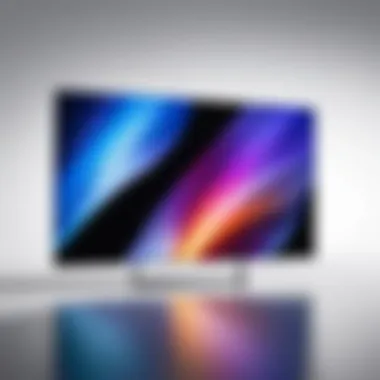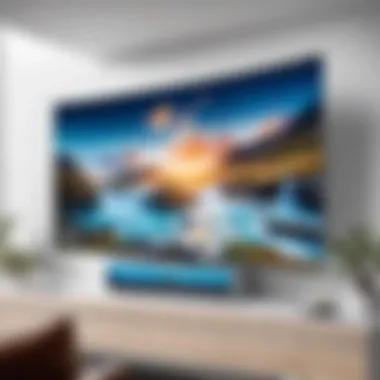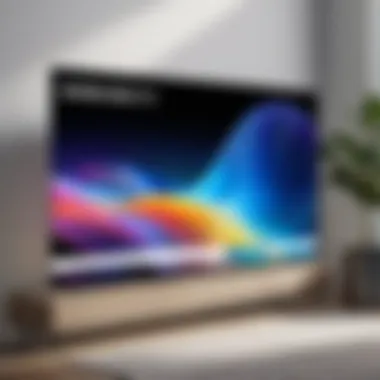Exploring Samsung QLED Sizes: A Comprehensive Guide


Intro
The Samsung QLED TV lineup stands as a testament to innovation in television technology. With various sizes available, understanding the dimensions and features of each model can be crucial for information technology professionals and tech enthusiasts looking to enhance their viewing experience. The growth of streaming services and 4K content makes the selection of the right TV even more significant. This guide provides insights into the offerings of Samsung's QLED series, analyzing the product dimensions while also discussing performance factors.
By delving into this topic, readers will not only learn how size impacts viewing experience but also gain a solid grasp of the technological advantages inherent in Samsung QLED displays.
Features Overview
Samsung QLED TVs are known for their remarkable features that cater to different user preferences. When considering this lineup, it is essential to look closely at key specifications and selling points.
Key Specifications
- Display Technology: Quantum Dot Technology, delivering a brighter and more vivid picture.
- Resolution Options: Available primarily in 4K and some models in 8K, catering to various viewing environments.
- HDR Support: High Dynamic Range support to optimize contrast and color accuracy, enhancing visuals for streaming and gaming.
- Smart Features: Built-in Tizen OS allows easy access to apps and content.
Unique Selling Points
Samsung's QLED offers several unique aspects that differentiate it from competitors:
- Color Volume: Retains exceptional color accuracy at various brightness levels.
- Anti-Reflection Technology: Minimizes reflections, enhancing viewing in bright rooms.
- Gaming Features: Low Input Lag and Variable Refresh Rate make them suitable for gamers.
- Customization Options: Available sizes fit a broad spectrum of spaces.
"Choosing the right size of a QLED TV is not just about aesthetics; it's about enhancing your overall viewing experience, especially when considering the technology at play."
Performance Analysis
A comprehensive analysis must include benchmarking results and real-world application scenarios. This gives insights into how the Samsung QLED TVs perform under various conditions.
Benchmarking Results
When reviewed, these TVs often score highly in several categories:
- Color Accuracy: Recorded near-perfect results in tests.
- Brightness Levels: Leading in brightness capacity, enhancing HDR content.
- Motion Handling: Excellent performance during fast motion scenes, which is vital for sports enthusiasts.
Real-world Scenarios
Users often report satisfying experiences in different settings:
- Living Room: Large models perform well, filling the space without overwhelming it, perfect for family movie nights.
- Gaming Setup: Smaller QLED sizes suit dedicated gaming areas without sacrificing performance.
- Office Use: Models that fit smaller screens still deliver impressive clarity during presentations.
In summarizing Samsung's QLED TV sizes and features, this guide aims to empower IT professionals and tech enthusiasts to select models that best fit their requirements. The blend of advanced technology and a wide range of options makes Samsung QLED TVs a compelling choice for enhanced viewing experiences.
Prologue to Samsung QLED Technology
Samsung's QLED technology represents a significant advancement in display innovation, integrating Quantum Dot technology to enhance the viewing experience. This introduction serves as a foundation, outlining the core principles of QLED and establishing its relevance in today’s market. Understanding how QLED works is crucial for potential buyers, especially for IT professionals and tech enthusiasts looking to make informed decisions when selecting the right television.
QLED TVs produce brighter images with vibrant colors, owing to the unique properties of quantum dots. These tiny semiconductor particles emit specific colors when exposed to light, thus creating a wider color gamut and better brightness compared to traditional LED displays. This ability to produce deep blacks and bright whites greatly enhances contrast, making content look more realistic and engaging.
Furthermore, Samsung's implementation of this technology comes with various features such as local dimming, which further improves black levels and contrast. It is important for consumers to consider these aspects as they impact the overall viewing experience, from casual viewing to professional applications.
Understanding QLED Fundamentals
QLED, or Quantum Dot Light Emitting Diode, relies on a series of layers that work together to create superior visuals. The foundation starts with a standard LED backlight, which then passes through a layer of quantum dots. These dots manipulate the incoming light and produce distinct colors. Here are some fundamentals of QLED:
- Color Accuracy: QLED technology offers impressive color accuracy, which is essential for both entertainment and professional color grading tasks.
- Brightness: One hallmark of QLED displays is their ability to reach high brightness levels, making them ideal for various lighting environments.
- Longevity: Unlike OLEDs, QLEDs do not suffer from burn-in, extending the lifespan of the display.
- Versatility: QLED TVs are versatile in different settings, from living rooms to conference rooms, due to their adaptability to varying ambient light.


Comparison with Other Display Technologies
When comparing QLED to other display technologies, such as OLED and traditional LCD, several distinctions become apparent.
- OLED: While OLED displays offer superior contrast and excellent viewing angles, they may experience burn-in issues and tend to be less bright than QLEDs.
- LCD: Traditional LCDs often lack the vibrant color and brightness levels found in QLED displays, making them less appealing for immersive viewing.
In summary, QLED technology stands out as a compelling choice in the modern display landscape, marrying the advantages of quantum dots with the familiarity of LED technology. Understanding these comparisons helps consumers evaluate their options based on specific needs and usage scenarios.
Overview of Samsung QLED Sizes
Understanding the size options available for Samsung QLED TVs is essential for making an informed purchasing decision. The design of a living space, the intended use of the TV, and personal viewing preferences all prominently influence this choice. This section aims to unpack these aspects and present the breadth of available sizes.
Standard Size Categories
Samsung QLED TVs come in a range of standard sizes designed to cater to various viewing needs and space configurations. These sizes typically include models ranging from 43 inches to 85 inches. Each size has a specific audience in mind. For instance, a 55-inch or 65-inch model is often popular in average-sized living rooms, balancing screen visibility and spatial requirement.
Common standard sizes include:
- 43 inches
- 50 inches
- 55 inches
- 65 inches
- 75 inches
- 85 inches
The appropriateness of each standard size depends on factors like room dimensions and the seating arrangement. Choosing the right size is critical to maximizing the viewing experience, as an oversized screen can dominate a small space, while a small screen can get lost in a larger room.
Detailed Analysis of Popular Sizes
In the realm of display technology, understanding the intricacies of various sizes is crucial. It plays a direct role in how viewers experience content, influencing their overall satisfaction. In this section, we will analyze three popular sizes of Samsung QLED TVs—fifty-inch, sixty-inch, and seventy-inch models. Each size offers unique benefits and considerations for potential owners. With the right knowledge, information technology professionals can make informed choices based on their specific needs and viewing environments.
Fifty-Inch Models
Fifty-inch models of Samsung QLED TVs strike a balance between screen size and usability. This size is often the most common for standard living rooms. It offers a wide viewing angle, enabling multiple viewers to enjoy a high-quality image without distortion. The fifty-inch screen provides enough visual real estate for various types of content, whether it's casual TV watching or gaming.
Additionally, these models generally fit well in most environments, making them versatile. They typically support 4K resolution, ensuring crisp visuals that make every detail pop. However, potential buyers should consider the optimal viewing distance. The recommended distance for a fifty-inch screen is usually around six to eight feet. This distance allows viewers to appreciate the full benefits of QLED technology without straining their eyes.
Sixty-Inch Variants
Sixty-inch variants present a notable upgrade in viewing experience. They amplify the visual details, making them ideal for film enthusiasts and gamers who appreciate high-definition graphics. The advantage of this size is its ability to fill the viewer’s field of vision more effectively, enhancing immersion during viewing.
As demand for larger screens grows, sixty-inch models are becoming increasingly popular. These TVs are commonly found in dedicated entertainment spaces. The ideal viewing distance for a sixty-inch screen expands to about seven to nine feet, providing ample space for sharp image quality.
Moreover, a sixty-inch QLED TV often features advanced picture technologies, such as local dimming, which improves contrast and color accuracy. This results in a superior image quality, making the sixty-inch variants highly appealing for serious viewers.
Seventy-Inch Options
Seventy-inch options offer an impressive canvas for content consumption, appealing largely to those desiring a true cinematic experience in their homes. This size significantly enhances visual impact, making large rooms feel more engaging and alive. For enthusiasts who watch sports, action movies, or play video games, the seventy-inch model effectively delivers a sense of scale that smaller TVs may lack.
The recommended viewing distance increases to approximately nine to eleven feet, allowing enough space for the extended size. It is also worth noting that these models can come equipped with cutting-edge tech, enhancing picture clarity, brightness, and color accuracy.
While a seventy-inch TV can be a stunning centerpiece for any room, installation does require careful consideration of space. Ensuring that the room has the appropriate dimensions and seating arrangement will prevent viewers from feeling overwhelmed by the screen.
"Choosing the right size is not just about personal preference, it also involves understanding how space, viewing distance, and content types influence the viewing experience."
Implications of Size on Viewing Experience
The size of a TV plays a critical role in shaping the overall viewing experience. It influences how immersive the content feels for the viewer. Choosing the right size means understanding how it interacts with the room's dimensions, viewing distance, and the type of content being consumed. As such, paying attention to size implications can vastly improve satisfaction and enjoyment over time.


Viewing Distance Recommendations
Determining the appropriate viewing distance is essential for maximizing the benefits of any TV size. Experts generally suggest that the optimal distance for viewing a 4K TV should be about 1.5 times the diagonal screen size. For instance, a fifty-inch Samsung QLED should be watched from approximately six to eight feet away. Similarly, larger screens, such as seventy-inch models, can be viewed from distances of about eight to ten feet.
- Fifty-Inch Model: 6 to 8 feet
- Sixty-Inch Model: 8 to 10 feet
- Seventy-Inch Model: 10 to 12 feet
Following these recommendations helps viewers appreciate the detail and clarity provided by QLED technology without straining their eyes. Failure to adjust the distance accordingly might lead to a disappointing experience, where resolution appears compromised.
Impact on Image Quality
Screen size directly affects image quality. Larger screens can showcase finer details, particularly when coupled with high-definition resolutions. The color accuracy, brightness, and contrast inherent in Samsung QLED models enhance the visual experience significantly. However, size must align with room lighting and the viewer’s seated position.
For example, a brightly lit room can diminish the perception of color vibrancy if the screen is too small. In contrast, a larger model can fill the field of view and engage the viewer more effectively, thus bringing images to life. Additionally, maintaining a proper distance is crucial; staying too close can cause a loss of detail, while a suitable distance complements the viewing angles and color range.
Effects on Room Aesthetics
The impact of a TV’s size goes beyond functionality; it significantly alters room aesthetics. A large QLED can become a focal point, setting the tone for the entire space. It can either enhance or clutter the design of a room, depending on how well it integrates.
- Larger TVs can overwhelm smaller spaces, making them feel cramped. It is important to consider not just the size of the screen, but also the available wall or stand that accommodates it.
- Compact models can provide versatility, allowing for placement in more varied spaces without the risk of being an eyesore.
Overall, a well-chosen size contributes to a harmonious environment that complements decor while delivering an enhanced viewing experience.
Evaluating Performance Across Sizes
Understanding the performance of Samsung QLED TVs across different sizes is essential for selection and setup. Each size can exhibit unique behaviors based on its resolution, brightness capabilities, and color renderings. Performance-related characteristics significantly impact user satisfaction and optimal viewing experiences. In this section, we will dissect the measurable components that define performance, highlighting the importance for tech-savvy consumers and IT professionals.
Brightness and Color Accuracy
Brightness in a QLED TV signifies its ability to produce vivid images. It is measured in nits, and most Samsung QLED models deliver impressive brightness levels. This characteristic is particularly important for environments with high ambient light. A standard definition is that the higher the brightness, the better the view in bright settings.
Color accuracy also plays a pivotal role. Samsung's Quantum Dot technology delivers an expansive color gamut. This means that colors appear true to life. When evaluating a larger screen, such as an 80-inch model, discrepancies in color accuracy may be more noticeable compared to a smaller 55-inch model. The integrity of color shifts based on size influences overall immersion.
"The performance of QLED size options reflects how well they can replicate the rich visual experience intended by content creators."
Considerations for viewers:
- Viewing Environment: Is the room light or dark?
- Source Quality: What is the resolution of your media?
- Calibration Needs: Do you require professional calibration for superior color precision?
Refresh Rates and Motion Handling
Refresh rates, measured in hertz, indicate how frequently the image is updated per second. For Samsung QLED TVs, a common refresh rate is 120 Hz. This aspect becomes crucial for fast-moving content like sports or action movies. In larger screens, like a 75-inch display, the smoothness of motion can either enhance or hinder the experience. A high refresh rate minimizes motion blur, providing clearer images during dynamic scenes.
Additionally, motion handling includes features such as motion interpolation, which helps reduce judder in video playback. A disparity in motion handling can manifest quickly in different sizes. Smaller sizes may not reveal motion artifacts as evidently as larger models might. This fact provides valuable insight for users who place a premium on high-speed content.
Key factors to assess:
- Content Type: What type of media will be viewed most frequently?
- User Experience: Are you sensitive to motion blur?
- Technology Integration: Are there features available to enhance motion performance?
Installation Considerations for Different Sizes
When selecting a Samsung QLED TV, it is crucial to consider how the size of the television will fit within your space. Installation considerations can significantly influence both the performance and the aesthetic appeal of the screen. The choice of location affects not just the visual experience but also the practicality of daily use.
Proper installation optimizes viewing angles and ensures that the TV operates within the best conditions. It's essential for potential buyers to evaluate both wall-mounting and stand options, as these decisions can dictate the setup and overall comfort in viewing. The dynamics of a room may warrant different types of installations based on size, layout, and design preferences.


Wall-Mounting Versus Stand Options
Wall-mounting a Samsung QLED provides a sleek, modern look that can free up valuable floor space. This option is particularly attractive for larger models. Wall-mounting also permits optimal height placement, allowing viewers to enjoy the best possible angle.
However, it involves precise measurements and installation. Buyers must ensure that the wall can handle the weight of the TV and consider electrical outlets for cords and cables. Incorrect installation can lead to hazards or damage to the wall itself.
Stand options are often simpler, allowing for flexibility. Users can easily rearrange and reposition the TV without committing to wall space. However, larger TVs may require sturdy furniture to support their weight. Additionally, the placement of other decorative items can be impacted when using a stand.
Space Requirements
Space considerations are integral in choosing the right size of Samsung QLED. The layout of the room should dictate the dimensions of the TV. For instance, a larger screen typically needs a more substantial viewing distance compared to smaller models.
Here are some key points to factor in:
- Room Size: Ensure the TV size complements the room. Too large of a TV can overwhelm a small room, while too small may appear lost in a larger space.
- Viewing Distance: Standard guidelines suggest a viewing distance of 1.5 to 2.5 times the diagonal size of the TV. For instance, a 65-inch TV would ideally have a viewing distance of about 8 to 13.5 feet.
- Furniture Layout: Consider how furniture placement will impact viewing angles. Avoid positioning seats too close to the screen to reduce eye strain.
"Choosing the right size and installation method is vital in enhancing the overall viewing experience with Samsung QLED TVs."
In summary, understanding the implications of installation and space requirements helps in making informed decisions when selecting a Samsung QLED TV. Each choice carries specific benefits and considerations that significantly affect both function and aesthetics.
Future Trends in QLED Sizes
The world of display technology is continuously evolving, and Samsung's QLED TV offerings are no exception. Keeping abreast of future trends is vital, especially for IT professionals and tech enthusiasts looking to make informed decisions. As consumers demand larger screens and better quality displays, the impact of such trends on purchasing decisions and viewing experience cannot be overlooked.
Emerging Sizes in Development
Samsung is exploring new avenues when it comes to display sizes. The demand for immersive viewing environments is pushing the boundaries of what was once considered standard. Emerging sizes, such as ultra-wide variations and innovative form factors, are under consideration. This reflects a shift towards customizing viewing experiences to suit varied spaces and preferences.
Key aspects include:
- Increased Screen Real Estate: Larger screen sizes provide a more engaging viewing experience. As sizes increase, so does the potential for multi-tasking applications, especially in professional environments.
- Flexible Size Options: Consumers are beginning to favor displays that can adapt to different spaces. This means that both smaller and larger options are designed to fit more seamlessly in homes and offices.
- Hybrid Sizes: Models that combine features of standard and ultra-wide formats might soon be available, appealing to a more diverse audience.
"Innovations in size offerings are not just about bigger screens. It's also about bringing personalized viewing experiences to the forefront."
Technological Advancements Impacting Size Offerings
Various factors shape the evolution of QLED sizes. Technological advancements play a crucial role in making larger displays feasible while maintaining quality. Here are some developments worth recognizing:
- Panel Technology: Improved manufacturing techniques allow for thinner and lighter panels. This paves the way for larger screens without compromising space or weight considerations.
- Resolution Improvement: Higher resolutions, such as 8K, may become standard in larger screen sizes. It enables viewers to experience sharp images, even on vast displays.
- Connectivity Options: With advancements in HDMI technology, including HDMI 2.1, consumers can expect better support for high-bandwidth features necessary for larger televisions.
As Samsung continues to innovate, closely monitoring these trends will prove essential for making strategic decisions in both consumer and professional settings.
Finale
Understanding the dimensions and varieties of Samsung QLED TVs is critical for making informed decisions. The insights gathered throughout this article help clarify how size impacts the viewing experience, performance, and overall installation considerations. Recognizing the specific elements of each model enables IT professionals and tech enthusiasts to more effectively connect their requirements with the right product offerings.
Recap of Key Insights
- Size Categories: The guide detailed standard sizes, compact options, and large formats. Each category serves different viewing habits and space considerations.
- Viewing Experience: Larger screens can enhance immersion but also demand appropriate viewing distances. This factor is not only about comfort but also about achieving optimal picture quality.
- Performance Differences: Variations in brightness, color accuracy, and refresh rates among different sizes influence overall viewing satisfaction.
- Installation Factors: Consider wall-mounting versus display stands and their impact on room aesthetics. Space requirements are key to prevent overcrowding the area.
- Future Trends: Emerging sizes and technological innovations point towards more personalized viewing experiences, tailoring to user preferences.
This synthesis reinforces the notion that choosing the right Samsung QLED TV involves more than just size; it necessitates a thorough consideration of viewing needs, room dimensions, and display capabilities.
Final Recommendations for Prospective Buyers
When looking to purchase a Samsung QLED TV, consider the following recommendations:
- Evaluate Your Space: Analyze your room layout to ensure the TV size fits comfortably within your visual range.
- Prioritize Your Viewing Habits: Think about how you use the TV. For gaming or sports, larger displays may enhance engagement, whereas a smaller set might suffice for casual viewing.
- Focus on Features: Beyond size, pay attention to features such as 4K resolution, HDR capabilities, and smart features, which also play significant roles in enhancing your experience.
- Research Future Trends: The market for Samsung QLED TVs is continuously evolving. Stay informed on upcoming models and features that may better suit future needs.
- Test before You Buy: If possible, check out TVs in a retail environment to compare different sizes and features before finalizing your purchase.
Engaging deeply with these aspects prepares buyers for a more profitable investment, optimizing both technology and enjoyment in their viewing experience.



